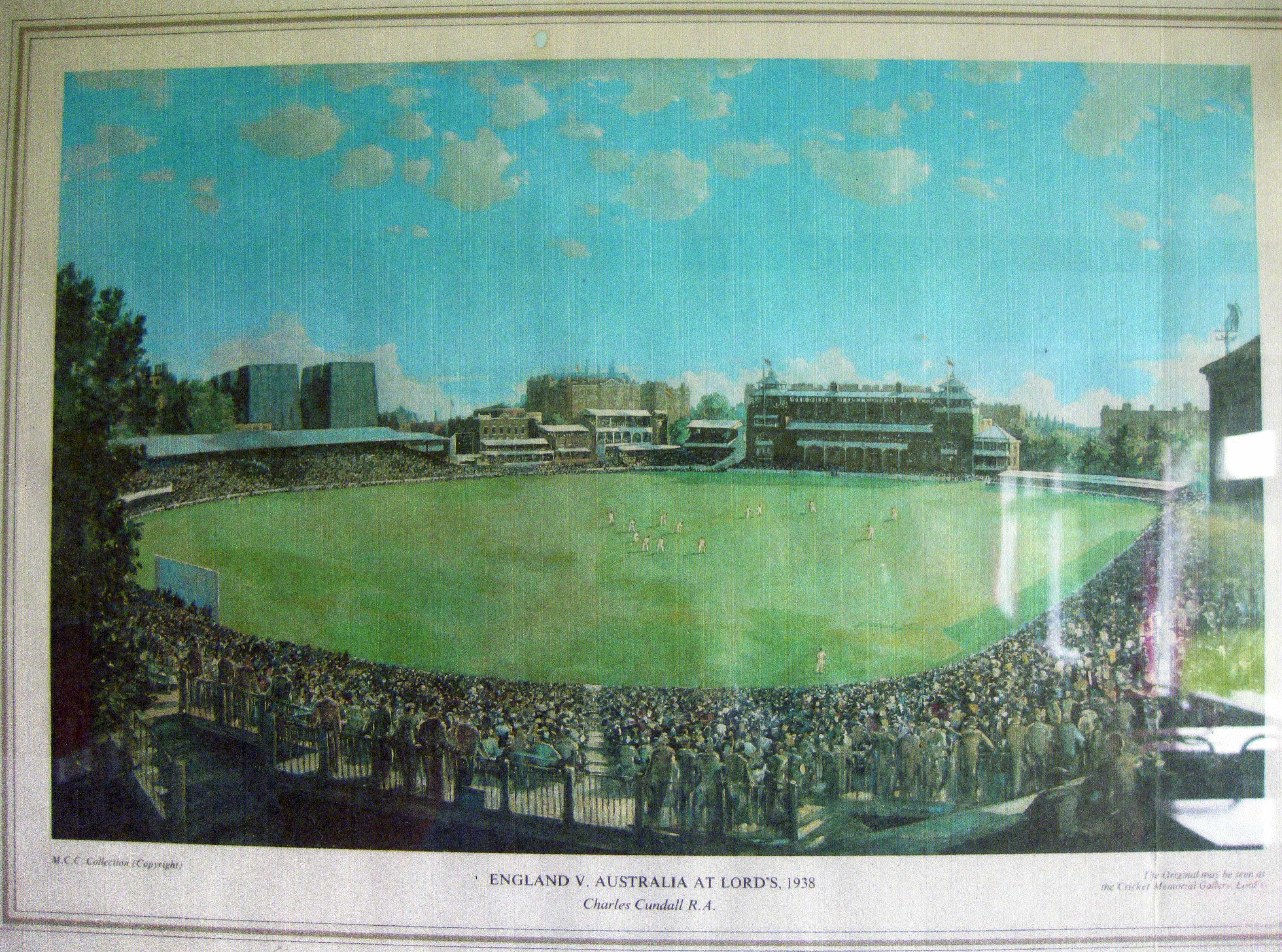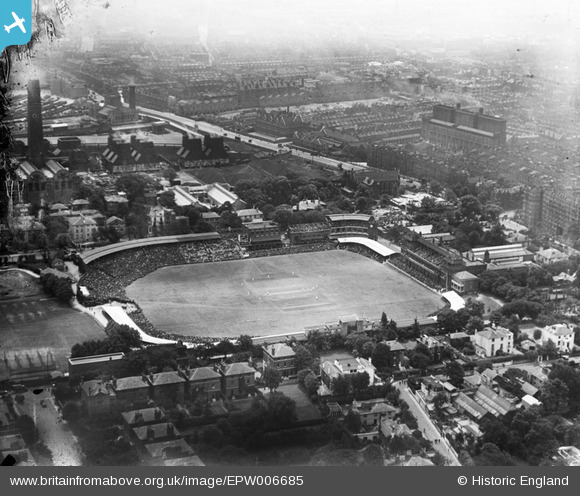EPW006685 ENGLAND (1921). St John's Wood, probably 2nd Ashes Test at Lords, 1921
© Hawlfraint cyfranwyr OpenStreetMap a thrwyddedwyd gan yr OpenStreetMap Foundation. 2025. Trwyddedir y gartograffeg fel CC BY-SA.
Delweddau cyfagos (31)
Manylion
| Pennawd | [EPW006685] St John's Wood, probably 2nd Ashes Test at Lords, 1921 |
| Cyfeirnod | EPW006685 |
| Dyddiad | June-1921 |
| Dolen | |
| Enw lle | ST JOHN'S WOOD |
| Plwyf | |
| Ardal | |
| Gwlad | ENGLAND |
| Dwyreiniad / Gogleddiad | 526850, 182675 |
| Hydred / Lledred | -0.17114995084347, 51.528238590429 |
| Cyfeirnod Grid Cenedlaethol | TQ269827 |
Pinnau
 AndyB |
Monday 11th of May 2015 10:32:53 PM | |
 Class31 |
Wednesday 10th of September 2014 12:39:29 PM | |
 John Swain |
Monday 19th of August 2013 07:29:39 PM | |
I think this is Aberdeen Place municipal Power Station, belonging to the borough of Marylebone. |
 AndyB |
Monday 11th of May 2015 10:31:01 PM |
 John Swain |
Monday 19th of August 2013 07:27:19 PM | |
 John Swain |
Monday 19th of August 2013 07:26:29 PM | |
 John Swain |
Wednesday 12th of September 2012 10:18:13 AM | |
 John Swain |
Wednesday 12th of September 2012 10:17:29 AM | |
 John Swain |
Wednesday 12th of September 2012 10:16:45 AM | |
 John Swain |
Wednesday 12th of September 2012 10:16:03 AM | |
 John Swain |
Wednesday 12th of September 2012 10:15:20 AM | |
 John Swain |
Wednesday 12th of September 2012 10:12:50 AM |
Cyfraniadau Grŵp
Lord's is simply the most famous and prestigious cricketing venue in the world. The Home of Cricket has an iconic status comparable to two other London sports grounds, Twickenham (1909) and Wembley (1923). This image captures the atmosphere of pre-war London NW8 (St.John's Wood and Maida Vale) during the Second Test Match between England and Australia, won convincingly by the visitors, within three days, by eight wickets. |
 John Swain |
Thursday 9th of May 2013 09:16:22 AM |
 Charles Cundall's portrait of Lord's during the Second Test against Australia on June 25, 1938, looking south from a packed Nursery End towards the Mound Stand and the massive cooling towers of Grove Road Power Station, which formed such a distinctive backdrop for over sixty years. The writer recalls their dominant aspect in his initial visit to the ground in August 1951, but they had been demolished by the time of his last trip twenty seasons later. |
 John Swain |
Thursday 13th of September 2012 09:46:09 AM |
Charles Cundall's famous portrait of Lord's Cricket Ground, looking almost due south from the Nursery Stand during the second Test against Australia. It was probably depicting play on Saturday, June 25, when the largest crowd assembled at headquarters, officially 33,800, witnessed a magnificent display by Wally Hammond, who scored 240 out of a total of 494 in six hours at the crease, including 32 boundaries. The game ended in a draw on the following Tuesday. This picture was issued as a print in 1973 and is reproduced here with the kind permission of Durham City Cricket Club. |
 John Swain |
Thursday 13th of September 2012 09:29:04 AM |
The second Ashes Test against Australia was held on June 11, 13 and 14, which resulted in a convincing win for the visitors by eight wickets. Wisden Cricketers' Almanack for 1922 reports that the match attracted great attention and on the Saturday (11th), the authorities had difficulty in accommodating the vast crowds, with lengthy delays for the ticket holders. Crowds of up to 32,000 were not infrequent during the 1920s. In the left background, beyond the Mound Stand and to the south of St. John's Wood Road, are the distinctive industrial landmark of the Grove Road Power Station cooling towers, built after 1902 and demolished about 60 years later. These "dark satanic mills" are a prominent feature in Charles Cundall's panoramic view of Lord's during the 1938 Test Match against Australia. |
 John Swain |
Wednesday 12th of September 2012 10:10:37 AM |


![[EPW006685] St John's Wood, probably 2nd Ashes Test at Lords, 1921](http://britainfromabove.org.uk/sites/all/libraries/aerofilms-images/public/100x100/EPW/006/EPW006685.jpg)
![[EPW006682] St John's Wood, probably 2nd Ashes Test at Lords, 1921](http://britainfromabove.org.uk/sites/all/libraries/aerofilms-images/public/100x100/EPW/006/EPW006682.jpg)
![[EPW006687] St John's Wood, probably 2nd Ashes Test at Lords, 1921](http://britainfromabove.org.uk/sites/all/libraries/aerofilms-images/public/100x100/EPW/006/EPW006687.jpg)
![[EPW006686] St John's Wood, probably 2nd Ashes Test at Lords, 1921](http://britainfromabove.org.uk/sites/all/libraries/aerofilms-images/public/100x100/EPW/006/EPW006686.jpg)
![[EPW006683] St John's Wood, probably 2nd Ashes Test at Lords, 1921](http://britainfromabove.org.uk/sites/all/libraries/aerofilms-images/public/100x100/EPW/006/EPW006683.jpg)
![[EPW021968] Lord's Cricket Ground and surroundings, St John's Wood, 1928](http://britainfromabove.org.uk/sites/all/libraries/aerofilms-images/public/100x100/EPW/021/EPW021968.jpg)
![[EPW006688] St John's Wood, probably 2nd Ashes Test at Lords, 1921](http://britainfromabove.org.uk/sites/all/libraries/aerofilms-images/public/100x100/EPW/006/EPW006688.jpg)
![[EPW006684] St John's Wood, probably 2nd Ashes Test at Lords, 1921](http://britainfromabove.org.uk/sites/all/libraries/aerofilms-images/public/100x100/EPW/006/EPW006684.jpg)
![[EAW006464] Lord's Cricket Ground, St John's Wood, 1947](http://britainfromabove.org.uk/sites/all/libraries/aerofilms-images/public/100x100/EAW/006/EAW006464.jpg)
![[EAW015848] Lord's Cricket Ground, St John's Wood, 1948. This image has been produced from a print.](http://britainfromabove.org.uk/sites/all/libraries/aerofilms-images/public/100x100/EAW/015/EAW015848.jpg)
![[EPW015772] Lord's Cricket Ground, St John's Wood, 1926](http://britainfromabove.org.uk/sites/all/libraries/aerofilms-images/public/100x100/EPW/015/EPW015772.jpg)
![[EPW006155] Lord's Cricket Ground, St John's Wood, 1921](http://britainfromabove.org.uk/sites/all/libraries/aerofilms-images/public/100x100/EPW/006/EPW006155.jpg)
![[EPW006681] St John's Wood, probably 2nd Ashes Test at Lords, 1921](http://britainfromabove.org.uk/sites/all/libraries/aerofilms-images/public/100x100/EPW/006/EPW006681.jpg)
![[EAW006465] Lord's Cricket Ground, St John's Wood, 1947](http://britainfromabove.org.uk/sites/all/libraries/aerofilms-images/public/100x100/EAW/006/EAW006465.jpg)
![[EAW024225] Lord's Cricket Ground, Day Two of the Second Test of the New Zealand Tour of England, 1949](http://britainfromabove.org.uk/sites/all/libraries/aerofilms-images/public/100x100/EAW/024/EAW024225.jpg)
![[EPW031880] Regents Parks and environs, Regent's Park, 1930](http://britainfromabove.org.uk/sites/all/libraries/aerofilms-images/public/100x100/EPW/031/EPW031880.jpg)
![[EAW030528] St John's Wood, a test match (England vs West Indies) underway at Lord's Cricket Ground, 1950](http://britainfromabove.org.uk/sites/all/libraries/aerofilms-images/public/100x100/EAW/030/EAW030528.jpg)
![[EAW006466] Lord's Cricket Ground, St John's Wood, 1947](http://britainfromabove.org.uk/sites/all/libraries/aerofilms-images/public/100x100/EAW/006/EAW006466.jpg)
![[EAW030527] St John's Wood, a test match (England vs West Indies) underway at Lord's Cricket Ground, 1950](http://britainfromabove.org.uk/sites/all/libraries/aerofilms-images/public/100x100/EAW/030/EAW030527.jpg)
![[EPW039574] Lord's Cricket Ground and environs, St John's Wood, 1932](http://britainfromabove.org.uk/sites/all/libraries/aerofilms-images/public/100x100/EPW/039/EPW039574.jpg)
![[EAW024224] Lord's Cricket Ground, Day Two of the Second Test of the New Zealand Tour of England, 1949](http://britainfromabove.org.uk/sites/all/libraries/aerofilms-images/public/100x100/EAW/024/EAW024224.jpg)
![[EPW009093] Lord's Cricket Ground and environs, St John's Wood, 1923](http://britainfromabove.org.uk/sites/all/libraries/aerofilms-images/public/100x100/EPW/009/EPW009093.jpg)
![[EAW030526] St John's Wood, a test match (England vs West Indies) underway at Lord's Cricket Ground, 1950](http://britainfromabove.org.uk/sites/all/libraries/aerofilms-images/public/100x100/EAW/030/EAW030526.jpg)
![[EAW015849] Lord's Cricket Ground, St John's Wood, 1948. This image has been produced from a print.](http://britainfromabove.org.uk/sites/all/libraries/aerofilms-images/public/100x100/EAW/015/EAW015849.jpg)
![[EAW024223] Lord's Cricket Ground, Day Two of the Second Test of the New Zealand Tour of England, 1949](http://britainfromabove.org.uk/sites/all/libraries/aerofilms-images/public/100x100/EAW/024/EAW024223.jpg)
![[EPW021969] Lord's Cricket Ground and surroundings, St John's Wood, 1928](http://britainfromabove.org.uk/sites/all/libraries/aerofilms-images/public/100x100/EPW/021/EPW021969.jpg)
![[EPW009007] Power Station on Regents Canal and Lord's Cricket Ground, St John's Wood, 1923. This image has been produced from a print.](http://britainfromabove.org.uk/sites/all/libraries/aerofilms-images/public/100x100/EPW/009/EPW009007.jpg)
![[EAW018353] Lord's Cricket Ground, Wellington Road and environs, St John's Wood, from the south-east, 1948. This image has been produced from a print.](http://britainfromabove.org.uk/sites/all/libraries/aerofilms-images/public/100x100/EAW/018/EAW018353.jpg)
![[EPW009006] Power Station on Regents Canal and Lord's Cricket Ground, St John's Wood, 1923](http://britainfromabove.org.uk/sites/all/libraries/aerofilms-images/public/100x100/EPW/009/EPW009006.jpg)
![[EPW009008] Power Station on Regents Canal and Lord's Cricket Ground, St John's Wood, 1923. This image has been produced from a print.](http://britainfromabove.org.uk/sites/all/libraries/aerofilms-images/public/100x100/EPW/009/EPW009008.jpg)
![[EAW044240] Lord's Cricket Ground and the surrounding area, St John's Wood, 1952](http://britainfromabove.org.uk/sites/all/libraries/aerofilms-images/public/100x100/EAW/044/EAW044240.jpg)
